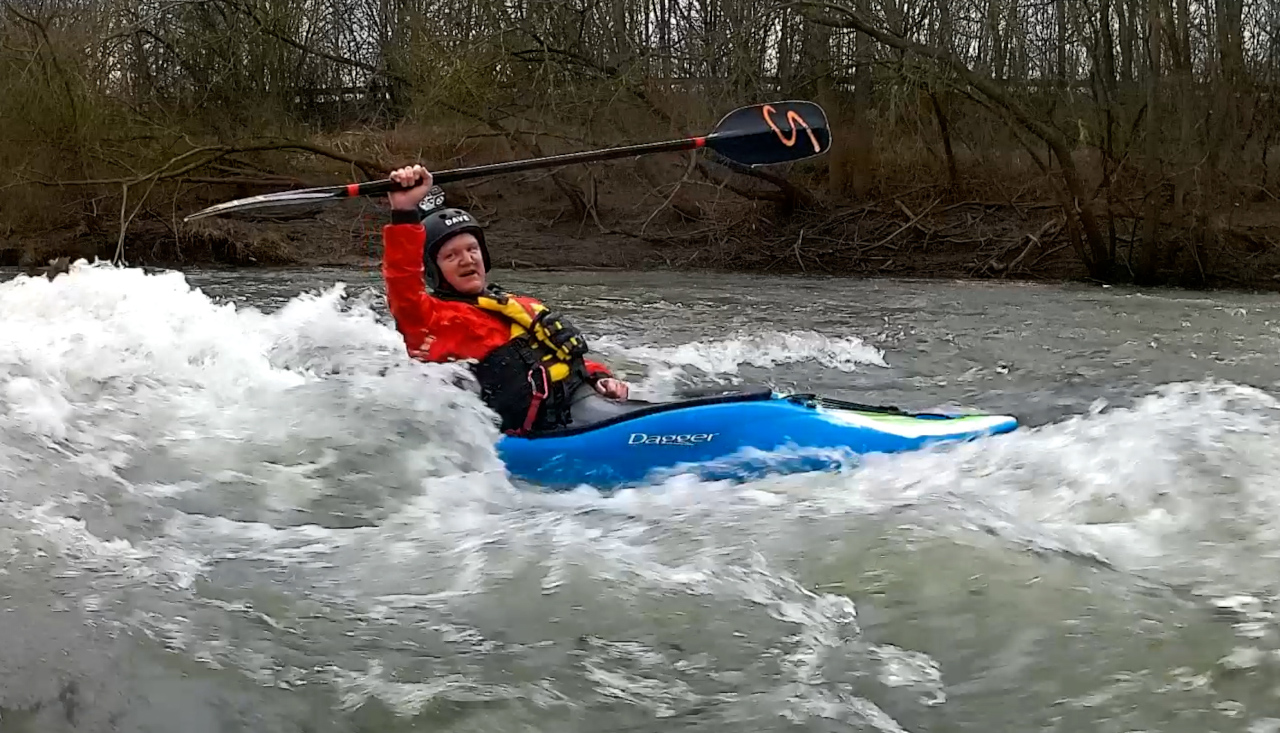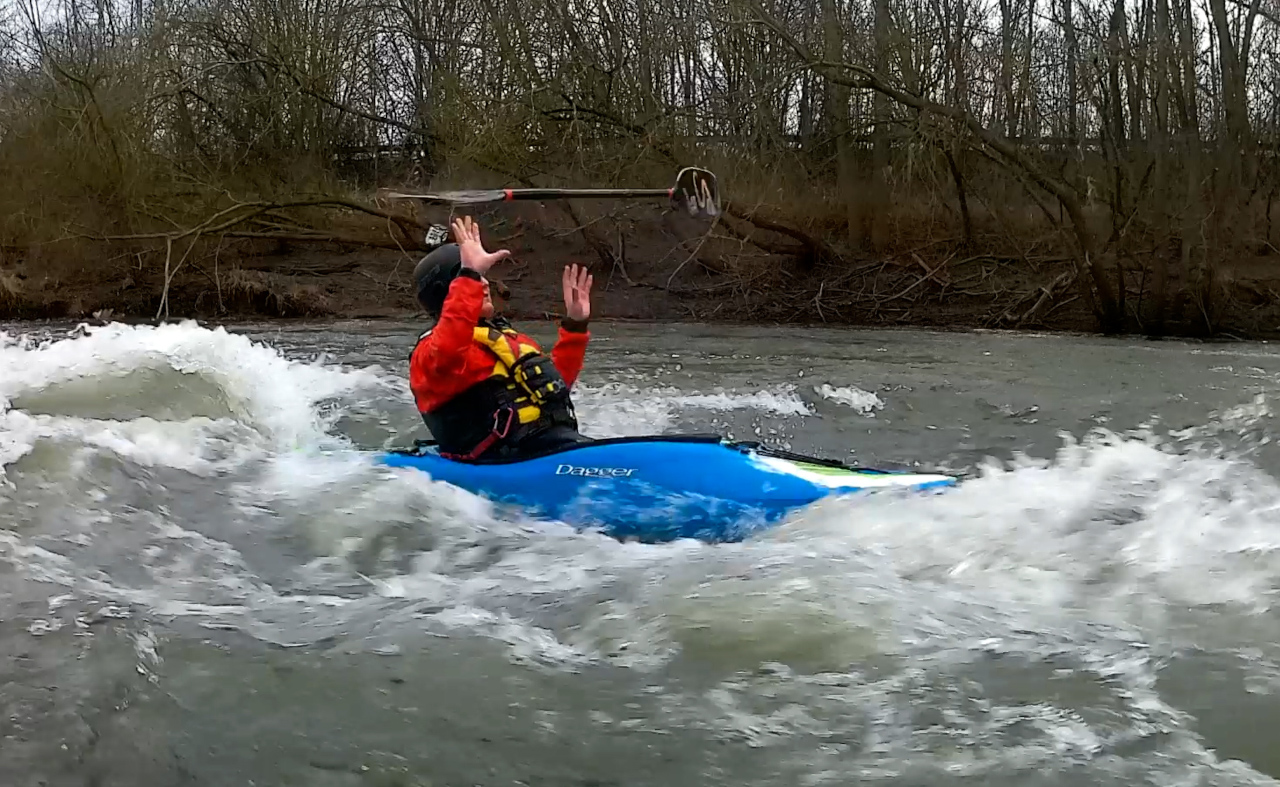How to kayak wave surf - 4 easy peasy steps to success
Wave surfing is a great skill to learn. With the right technique, it can be used on a wide variety of waves - both big and small - and it's easy peasy once you know how.
 Waves are great places to do some tricks
Waves are great places to do some tricksOn continuous white water, surfing a wave can provide a resting place and an opportunity to gather your thoughts before moving on. For serious playboaters, a wave is used to perform all sorts of tricks including spins and loops.
We are going to focus on the four key steps needed to undertake a wave surf.
These are:
- Lift off
- Staying on
- Paddle strokes
- Exiting the wave
Step 1 - Lift off
Getting on the wave can be the most difficult part of wave surfing. It's either a great surf or you'll miss the wave and risk a capsize.
The usual way to approach the wave is from an eddy at the side of the wave. Your position in the eddy should be at least level with the lowest bit of water in front of the wave. It's called the trough.
Your kayak should be
facing upstream. You are going to control the way the kayak moves onto the wave
using the angle of the kayak rather than the power of your paddle strokes.
Don't worry, it's
easier than it sounds!
From the eddy, you
should angle your kayak towards the wave like this. Not much angle - perhaps
between 5 and 10 degrees.
If needed, a very
light paddle stroke on the shore side of the kayak will initiate the move onto
the edge of the wave.
As the kayak begins
to glide onto the wave, you can use a paddle stroke on the opposite side of the
kayak to make sure the kayak does not continue to turn as it moves on to the
wave.
The angle of 5 to 10 degrees must be maintained as this makes the entry to the wave much easier. A common mistake is to let the kayak go because too much angle is applied - as is shown here. This means you miss the wave, or if you are very unlucky and lean upstream, you capsize.
 Surfing the inlet wave at Holme Pierrepont
Surfing the inlet wave at Holme PierrepontStep 2 - Staying On
Once the kayak is on the wave, you will feel the wave support the kayak and stop it flowing back downstream with the current.
The slope of the wave and gravity helps with this.
Keep your body upright, the bottom of the kayak as flat as possible and lean back. Lean further back on bigger waves to avoid the nose of the kayak dipping under the water and pushing you off the wave.
Step 3 - Paddle
Strokes
Your goal now is to keep the kayak pointing upstream at all times. A movement of 5 to 10 degrees each way is fine and you can control this by dropping the paddle blade in the water on the opposite side of the kayak to counter the movement like this.
Remember, your paddle is a very strong lever and in fast water even a small stroke can make a big difference to the angle of the kayak. It's best to use quick and light strokes instead.
Step 4 - Exiting The Wave
Hopefully you have maintained your wave surf for a short period of time. It's now time to leave the wave.
Check behind you to ensure there are no obstacles or other paddlers.
Allow the angle of the kayak to extend beyond the 10 degrees and you will begin to turn to point downstream.
As you turn, you must lean downstream - or you may capsize.
Keep your paddle ready and put in some forward paddle strokes to move the kayak away from the wave.
And, as with any kayak skill, you must practice. Any wave on a river is a potential surf. Small, medium or large - give it a go!
 A 'throw and catch' on the wave - a nod to the 80's perhaps
A 'throw and catch' on the wave - a nod to the 80's perhapsHere's a video tutorial for you...
PS. Paddlesports can be dangerous.
Read our safety disclaimer - here

New paddling inspiration, tip, trip or technique video EVERY week! Watch Ed, Dave and Moo on their kayaking, canoe and SUP adventures. It's all about having fun on the water. 169,000+ views, 100+ videos & 700+ subscribers so far! Click below to start watching:
Ed & Dave Kayaking Youtube Channel
WANT TO HELP US?
We really value your visit to us today. We run this website and our Youtube channel to provide paddling inspiration, tips, trip and technique content to you. We love being out on the water! If you enjoyed your visit, you can support us by using the links below:
Buy us something on our wish list
Thank you
NEED WEB HOSTING?
We recommend IONOS. Great service, technical support and stable hosting. Click the link below to find out more:
IONOS Web Hosting - RECOMMENDED!



